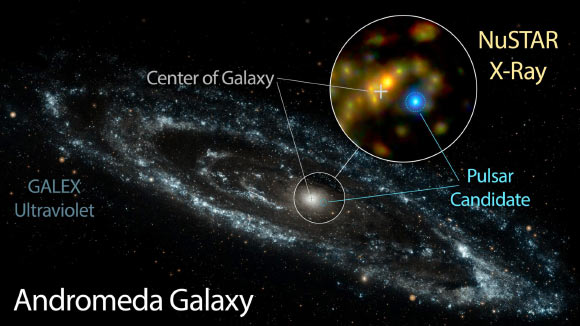The Andromeda galaxy (also known as Messier 31) features a dominant source of hard X-rays, but its identity was mysterious until now. An international team of scientists, led by astronomers at Johns Hopkins University, has successfully identified an object responsible for this high-energy radiation.

Swift J0042.6+4112 is brighter at high energies than the Andromeda galaxy’s entire black hole population. The inset image shows the pulsar candidate in blue, as seen in X-ray light by NASA’s NuSTAR mission. The background image of the Andromeda galaxy was taken by NASA’s Galaxy Evolution Explorer in UV light. Image credit: NASA / JPL-Caltech / GSFC / JHU.
The object in question, called Swift J0042.6+4112, is a possible pulsar. Its spectrum is very similar to known pulsars in our Milky Way Galaxy.
According to the team, Swift J0042.6+4112 is likely in a binary system, in which material from a stellar companion gets pulled onto the pulsar, spewing high-energy radiation as the material heats up.
“We didn’t know what it was until we looked at it with NASA’s Nuclear Spectroscopic Telescope Array (NuSTAR),” said Mihoko Yukita, an assistant research scientist at the Department of Physics and Astronomy at Johns Hopkins University, and lead author of a study about the object, published in the Astrophysical Journal (arXiv.org preprint).
In 2013, NASA’s Swift satellite reported Swift J0042.6+4112 as a high-energy source, but its classification was unknown, as there are many objects emitting low energy X-rays in the region.
The lower-energy X-ray emission from the object turns out to be a source first identified in the 1970s by NASA’s Einstein Observatory.
Other spacecraft, such as NASA’s Chandra X-ray Observatory and ESA’s XMM-Newton had also detected it.
However, it wasn’t until the new study that astronomers realized it was the same object as this likely pulsar that dominates the high-energy X-ray light of the Andromeda galaxy.
Traditionally, researchers have thought that actively feeding black holes, which are more massive than pulsars, usually dominate the high-energy X-ray light in galaxies. As gas spirals closer and closer to the black hole in a structure called an accretion disk, this material gets heated to extremely high temperatures and gives off high-energy radiation.
Swift J0042.6+4112, which has a lower mass than any of Andromeda’s black holes, is brighter at high energies than the galaxy’s entire black hole population.
Even the supermassive black hole in the center of Andromeda does not have significant high-energy X-ray emission associated with it.
It is unexpected that a single pulsar would instead be dominating the galaxy in high-energy X-rays.
_____
M. Yukita et al. 2017. Identification of the Hard X-ray Source Dominating the E > 25 keV Emission of the Nearby Galaxy M31. ApJ 838, 47; doi: 10.3847/1538-4357/aa62a3
This article is based on a press-release from the National Aeronautics and Space Administration.







